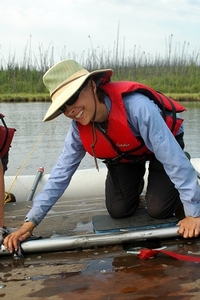


Research
| The broad goal of my research is to understand the patterns and controls of past and present ecosystem change across multiple spatial and temporal scales. I am specifically interested in the influence of vegetation community, land form, climate change, and disturbance on ecosystems and in applying this knowledge to anticipate and plan for future change. The use of multiple records of environmental change, covering large spatial and temporal scales, can help improve our understanding of natural and anthropogenic disturbance regimes to better inform policy, managers, and models in predicting future environmental change. |
Publications
|
Thesis abstractArea burned has doubled in Alaskan boreal forest over the past several decades, and fires are expected to increase in frequency and size as a result of anthropogenic climate change in the 21st century. Because wildfires have an important regulatory role in maintaining boreal forests, fire-regime shifts can have large ecological and socioeconomic repercussions. Understanding the patterns and controls of forest fires is crucial for anticipating future fire-regime shifts at local to regional scales. To assess top-down (climate) and bottom-up (land cover) controls, I conducted paleoecological analyses spanning the past 7000 years and landscape analyses of the past decade. I used macrocharcoal to reconstruct fire history based on lake-sediment cores collected from 24 lakes in south-central Alaska. These records were compared to regional paleoclimate records to elucidate the response of boreal fire regimes to climate change. To assess the importance of bottom-up controls, I compared the spatial relationships between land cover, fire history, and climate in Alaska over the past decade. My results show that climate and land cover both exert important controls of boreal forest fires. Over the past 3000 years, regional biomass burning is correlated with summer temperature variation in the Northern Hemisphere (r = 0.68, p < 0.01). Moreover, over the past decade, warm and dry summers (quantified by precipitation - potential evapotranspiration) are correlated with annual area burned (r = -0.81, p < 0.01) and total number of fires (r = -0.89, p < 0.01). Among the land-cover types, coniferous forest and woody wetland are positively correlated with area burned whereas shrub-scrub, dwarf scrub, and fuel-free (open water and barren) areas are all negatively correlated with area burned over the past decade. The density and spatial arrangement of open water on the landscape also had a large influence on the fire regime. Over the past 7000 years, fire history records with local landscapes with an abundance of water bodies had a lack of fires, whereas records from areas with few water bodies had distinct charcoal peaks. Thus, we can infer that water bodies can function as natural fire breaks that limit the spread of fire. These results suggest that vegetation does not burn randomly and land cover can have major effects on fire regimes. Land-cover and climate controls interact and shift in their relative importance through time, highlighting the complexity of fire regime controls. My results reveal that biomass burning and mean summer temperature are not significantly correlated from 6000-3000 years ago, but become positively correlated with varying correlation strengths from 3000 years ago to present (r = 0.40-0.66, p = 0.001- 0.040, using 2000-yr moving windows). This shift suggests that climate became a more important fire regime control 3000 years ago, likely as a result of vegetation shifts in the region. Land-cover influence on the climatic controls of biomass burning is also evidenced by the significant correlation between the amount of open water within 5 km of each study and biomass burning during the coolest periods (r = -0.21, p = 0.02), but not the warmest periods (r = -0.05, p = 0.30). When examining all major land cover classes, dissimilarity analysis reveals that the proportion of land cover burning is more similar to a null model of vegetation burning in warmer/drier years than in cooler/wetter years, suggesting that land cover plays a more important role in controlling area burned when climate conditions are less favorable for wildfires. Overall my research shows that fires are driven by complex controls that are interactive and dynamic over a range of spatiotemporal scales. These results imply that continued anthropogenic warming and drying may be associated with increases in biomass burning as a result of the drying of water bodies and fuel. However, our results spanning decades to millennia also indicate that changes in the vegetation composition of Alaskan boreal forests can dictate the influence of climate on the fire regime. Thus, the possibility exists that an increased prevalence of early-successional vegetation, resulting from increased fire frequency and severity, may exert a negative feedback to biomass burning. |

